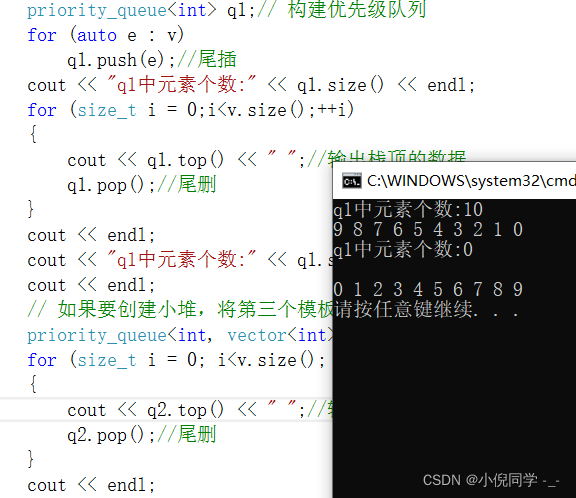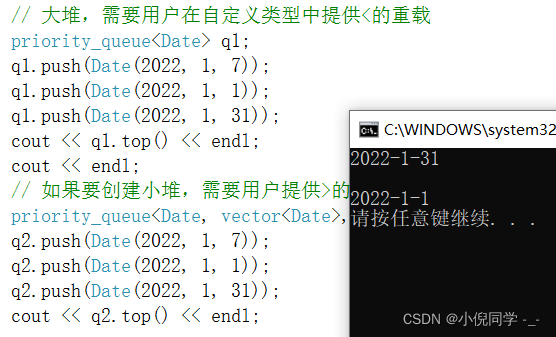C++ priority_queue
小倪同学 -_- 人气:0priority_queue的使用
priority_queue简介
- 优先队列是一种容器适配器,有严格的排序标准,它的第一个元素总是它所包含的元素中最大的(或最小的)。
- 此上下文类似于堆,在堆中可以随时插入元素,并且只能检索最大堆(或 最小堆)元素(优先队列中位于顶部的元素)。
- 默认情况下,如果没有为特定的priority_queue类实例化指定容器类,则使用vector。
priority_queue的使用
| 成员函数 | 功能 |
|---|---|
| push | 插入数据 |
| pop | 删除优先级队列中最大(最小)元素,即堆顶元素 |
| top | 返回优先级队列中最大(最小)元素,即堆顶元素 |
| empty | 检测优先级队列是否为空 |
| size | 获取队列中有效元素个数 |
void TestPriorityQueue()
{
// 默认情况下,创建的是大堆,其底层按照小于号比较
vector<int> v{ 3, 2, 7, 6, 0, 4, 1, 9, 8, 5 };
priority_queue<int> q1;// 构建优先级队列
for (auto e : v)
q1.push(e);//尾插
cout << "q1中元素个数:" << q1.size() << endl;
for (size_t i = 0;i<v.size();++i)
{
cout << q1.top() << " ";//输出栈顶的数据
q1.pop();//尾删
}
cout << endl;
cout << "q1中元素个数:" << q1.size() << endl;
cout << endl;
// 如果要创建小堆,将第三个模板参数换成greater比较方式
priority_queue<int, vector<int>, greater<int>> q2(v.begin(), v.end());
for (size_t i = 0; i<v.size(); ++i)
{
cout << q2.top() << " ";//输出栈顶的数据
q2.pop();//尾删
}
cout << endl;
}

如果在priority_queue中放自定义类型的数据,用户需要在自定义类型中提供> 或者< 的重载。
class Date
{
public:
Date(int year = 1900, int month = 1, int day = 1)
: _year(year)
, _month(month)
, _day(day)
{}
bool operator<(const Date& d)const
{
return (_year < d._year) ||
(_year == d._year && _month < d._month) ||
(_year == d._year && _month == d._month && _day < d._day);
}
bool operator>(const Date& d)const
{
return (_year > d._year) ||
(_year == d._year && _month > d._month) ||
(_year == d._year && _month == d._month && _day > d._day);
}
friend ostream& operator<<(ostream& _cout, const Date& d)
{
_cout << d._year << "-" << d._month << "-" << d._day;
return _cout;
}
private:
int _year;
int _month;
int _day;
};
void TestPriorityQueue()
{
// 大堆,需要用户在自定义类型中提供<的重载
priority_queue<Date> q1;
q1.push(Date(2022, 1, 7));
q1.push(Date(2022, 1, 1));
q1.push(Date(2022, 1, 31));
cout << q1.top() << endl;
cout << endl;
// 如果要创建小堆,需要用户提供>的重载
priority_queue<Date, vector<Date>, greater<Date>> q2;
q2.push(Date(2022, 1, 7));
q2.push(Date(2022, 1, 1));
q2.push(Date(2022, 1, 31));
cout << q2.top() << endl;
}

priority_queue的模拟实现
priority_queue的底层实际上就是堆结构,可以参考博主之前写的有关堆的文章数据结构之堆
namespace nzb
{
//比较方式(使内部结构为大堆)
template<class T>
class Less
{
public:
bool operator()(const T& x, const T& y)
{
return x < y;
}
};
//比较方式(使内部结构为小堆)
template<class T>
class Greater
{
public:
bool operator()(const T& x, const T& y)
{
return x > y;
}
};
template<class T, class Container = vector<T>, class Compare = Less<T>>
class priority_queue
{
public:
priority_queue()
{}
template<class InputIterator>
priority_queue(InputIterator first, InputIterator last)
{
//将迭代器中的数据插入优先级队列中
while (first != last)
{
_con.push_back(*first);
first++;
}
//从最后一个非叶子结点向上调整
for (int i = (_con.size() - 1 - 1) / 2; i >= 0; i--)
{
AdjustDown(i);
}
}
//堆的向上调整
void AdjustUp(size_t child)
{
size_t parent = (child - 1) / 2;//找到父节点
while (child > 0)
{
if (_com(_con[parent], _con[child]))//判断是否需要交换
{
//交换父子结点
swap(_con[parent], _con[child]);
//继续向上调整
child = parent;
parent = (child - 1) / 2;
}
else
{
break;
}
}
}
//向下调整
void AdjustDown(size_t parent)
{
size_t child = parent * 2 + 1;//算出左子节点的下标
while (child < _con.size())
{
//找出子结点中符合比较方式的值
if (child + 1 < _con.size() && _com(_con[child], _con[child + 1]))
{
child++;
}
//通过所给比较方式确定是否需要交换结点位置
if (_com(_con[parent], _con[child]))
{
//交换父子结点
swap(_con[parent], _con[child]);
//继续向下调整
parent = child ;
child = parent * 2 + 1;
}
else
{
break;
}
}
}
//插入数据
void push(const T& x)
{
_con.push_back(x);
AdjustUp(_con.size() - 1);//将最后一个元素向上调整
}
//删除数据
void pop()
{
swap(_con[0], _con[_con.size() - 1]);//交换首尾数据
_con.pop_back();//尾删
AdjustDown(0);//首元素向下调整
}
//访问头元素
const T& top() const
{
return _con[0];
}
//获取队列中有效元素个数
size_t size()
{
return _con.size();
}
//判空
bool empty()
{
return _con.empty();
}
private:
Container _con;//底层容器
Compare _com;//比较方式
};
}
加载全部内容